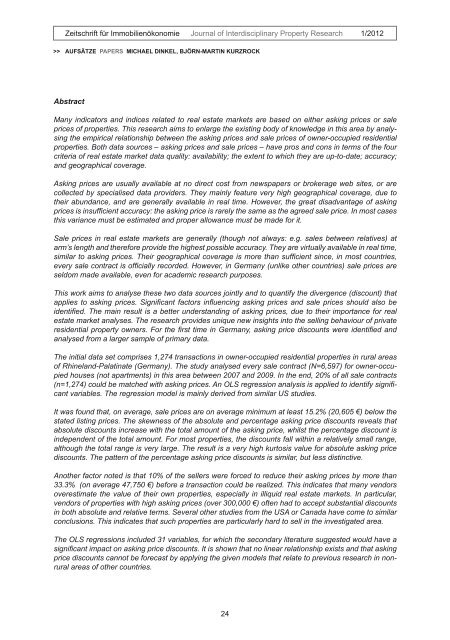Asking prices and sale prices of owner-occupied houses in rural ...
Asking prices and sale prices of owner-occupied houses in rural ...
Asking prices and sale prices of owner-occupied houses in rural ...
Erfolgreiche ePaper selbst erstellen
Machen Sie aus Ihren PDF Publikationen ein blätterbares Flipbook mit unserer einzigartigen Google optimierten e-Paper Software.
Zeitschrift für Immobilienökonomie Journal <strong>of</strong> Interdiscipl<strong>in</strong>ary Property Research 1/2012<br />
>> Aufsätze PAPers MichAel D<strong>in</strong>kel, Björn-MArt<strong>in</strong> kurzrock<br />
Abstract<br />
Many <strong>in</strong>dicators <strong>and</strong> <strong>in</strong>dices related to real estate markets are based on either ask<strong>in</strong>g <strong>prices</strong> or <strong>sale</strong><br />
<strong>prices</strong> <strong>of</strong> properties. This research aims to enlarge the exist<strong>in</strong>g body <strong>of</strong> knowledge <strong>in</strong> this area by analys<strong>in</strong>g<br />
the empirical relationship between the ask<strong>in</strong>g <strong>prices</strong> <strong>and</strong> <strong>sale</strong> <strong>prices</strong> <strong>of</strong> <strong>owner</strong>-<strong>occupied</strong> residential<br />
properties. Both data sources – ask<strong>in</strong>g <strong>prices</strong> <strong>and</strong> <strong>sale</strong> <strong>prices</strong> – have pros <strong>and</strong> cons <strong>in</strong> terms <strong>of</strong> the four<br />
criteria <strong>of</strong> real estate market data quality: availability; the extent to which they are up-to-date; accuracy;<br />
<strong>and</strong> geographical coverage.<br />
<strong>Ask<strong>in</strong>g</strong> <strong>prices</strong> are usually available at no direct cost from newspapers or brokerage web sites, or are<br />
collected by specialised data providers. They ma<strong>in</strong>ly feature very high geographical coverage, due to<br />
their abundance, <strong>and</strong> are generally available <strong>in</strong> real time. However, the great disadvantage <strong>of</strong> ask<strong>in</strong>g<br />
<strong>prices</strong> is <strong>in</strong>sufficient accuracy: the ask<strong>in</strong>g price is rarely the same as the agreed <strong>sale</strong> price. In most cases<br />
this variance must be estimated <strong>and</strong> proper allowance must be made for it.<br />
Sale <strong>prices</strong> <strong>in</strong> real estate markets are generally (though not always: e.g. <strong>sale</strong>s between relatives) at<br />
arm’s length <strong>and</strong> therefore provide the highest possible accuracy. They are virtually available <strong>in</strong> real time,<br />
similar to ask<strong>in</strong>g <strong>prices</strong>. Their geographical coverage is more than sufficient s<strong>in</strong>ce, <strong>in</strong> most countries,<br />
every <strong>sale</strong> contract is <strong>of</strong>ficially recorded. However, <strong>in</strong> Germany (unlike other countries) <strong>sale</strong> <strong>prices</strong> are<br />
seldom made available, even for academic research purposes.<br />
This work aims to analyse these two data sources jo<strong>in</strong>tly <strong>and</strong> to quantify the divergence (discount) that<br />
applies to ask<strong>in</strong>g <strong>prices</strong>. Significant factors <strong>in</strong>fluenc<strong>in</strong>g ask<strong>in</strong>g <strong>prices</strong> <strong>and</strong> <strong>sale</strong> <strong>prices</strong> should also be<br />
identified. The ma<strong>in</strong> result is a better underst<strong>and</strong><strong>in</strong>g <strong>of</strong> ask<strong>in</strong>g <strong>prices</strong>, due to their importance for real<br />
estate market analyses. The research provides unique new <strong>in</strong>sights <strong>in</strong>to the sell<strong>in</strong>g behaviour <strong>of</strong> private<br />
residential property <strong>owner</strong>s. For the first time <strong>in</strong> Germany, ask<strong>in</strong>g price discounts were identified <strong>and</strong><br />
analysed from a larger sample <strong>of</strong> primary data.<br />
The <strong>in</strong>itial data set comprises 1,274 transactions <strong>in</strong> <strong>owner</strong>-<strong>occupied</strong> residential properties <strong>in</strong> <strong>rural</strong> areas<br />
<strong>of</strong> Rh<strong>in</strong>el<strong>and</strong>-Palat<strong>in</strong>ate (Germany). The study analysed every <strong>sale</strong> contract (N=6,597) for <strong>owner</strong>-<strong>occupied</strong><br />
<strong>houses</strong> (not apartments) <strong>in</strong> this area between 2007 <strong>and</strong> 2009. In the end, 20% <strong>of</strong> all <strong>sale</strong> contracts<br />
(n=1,274) could be matched with ask<strong>in</strong>g <strong>prices</strong>. An OLS regression analysis is applied to identify significant<br />
variables. The regression model is ma<strong>in</strong>ly derived from similar US studies.<br />
It was found that, on average, <strong>sale</strong> <strong>prices</strong> are on average m<strong>in</strong>imum at least 15.2% (20,605 €) below the<br />
stated list<strong>in</strong>g <strong>prices</strong>. The skewness <strong>of</strong> the absolute <strong>and</strong> percentage ask<strong>in</strong>g price discounts reveals that<br />
absolute discounts <strong>in</strong>crease with the total amount <strong>of</strong> the ask<strong>in</strong>g price, whilst the percentage discount is<br />
<strong>in</strong>dependent <strong>of</strong> the total amount. For most properties, the discounts fall with<strong>in</strong> a relatively small range,<br />
although the total range is very large. The result is a very high kurtosis value for absolute ask<strong>in</strong>g price<br />
discounts. The pattern <strong>of</strong> the percentage ask<strong>in</strong>g price discounts is similar, but less dist<strong>in</strong>ctive.<br />
Another factor noted is that 10% <strong>of</strong> the sellers were forced to reduce their ask<strong>in</strong>g <strong>prices</strong> by more than<br />
33.3% (on average 47,750 €) before a transaction could be realized. This <strong>in</strong>dicates that many vendors<br />
overestimate the value <strong>of</strong> their own properties, especially <strong>in</strong> illiquid real estate markets. In particular,<br />
vendors <strong>of</strong> properties with high ask<strong>in</strong>g <strong>prices</strong> (over 300,000 €) <strong>of</strong>ten had to accept substantial discounts<br />
<strong>in</strong> both absolute <strong>and</strong> relative terms. Several other studies from the USA or Canada have come to similar<br />
conclusions. This <strong>in</strong>dicates that such properties are particularly hard to sell <strong>in</strong> the <strong>in</strong>vestigated area.<br />
The OLS regressions <strong>in</strong>cluded 31 variables, for which the secondary literature suggested would have a<br />
significant impact on ask<strong>in</strong>g price discounts. It is shown that no l<strong>in</strong>ear relationship exists <strong>and</strong> that ask<strong>in</strong>g<br />
price discounts cannot be forecast by apply<strong>in</strong>g the given models that relate to previous research <strong>in</strong> non<strong>rural</strong><br />
areas <strong>of</strong> other countries.<br />
24


